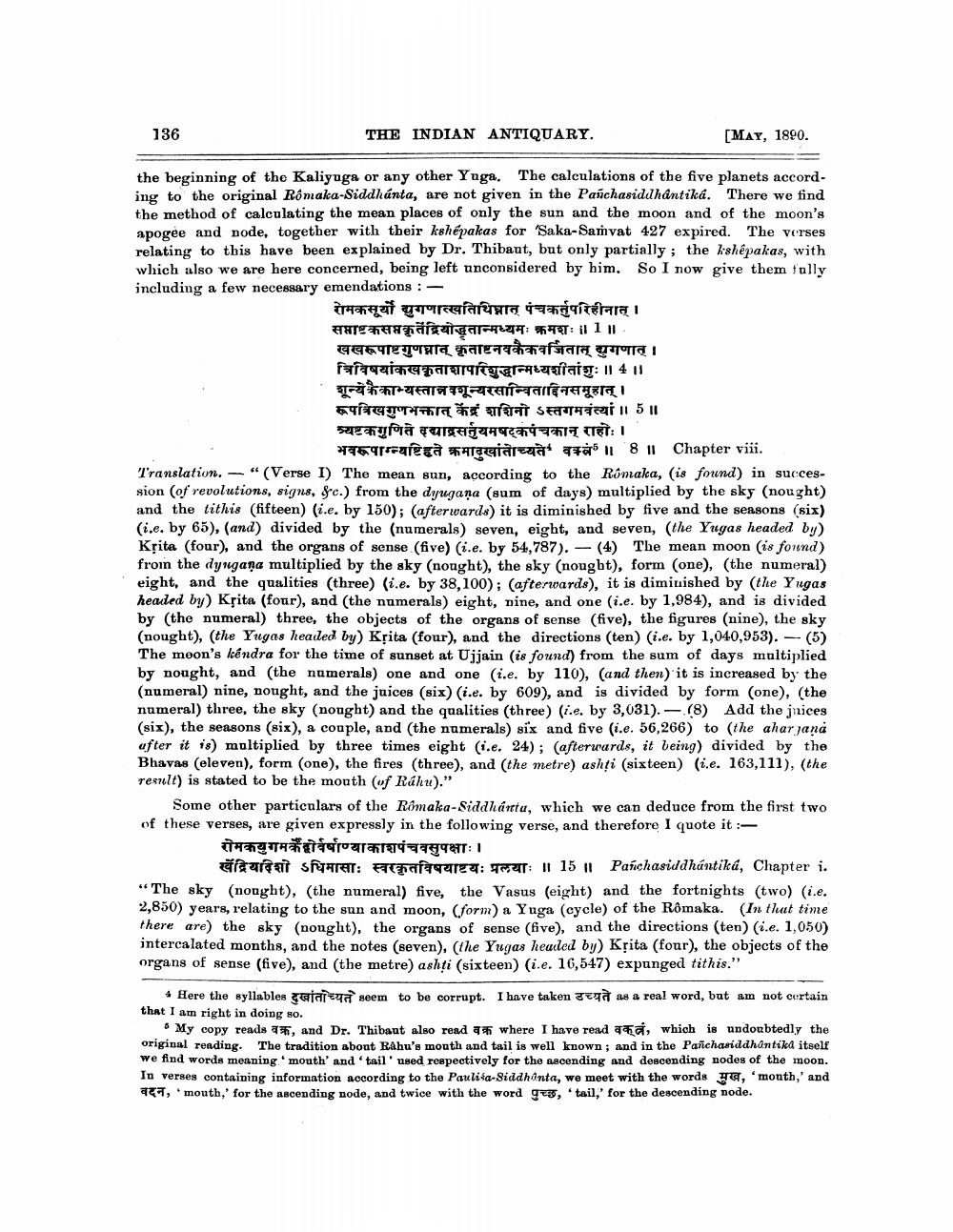________________
136
THE INDIAN ANTIQUARY.
[MAY, 1890.
the beginning of the Kaliyuga or any other Yuga. The calculations of the five planets according to the original Rómaka-Siddhánta, are not given in the Panchasiddhantika. There we find the method of calculating the mean places of only the sun and the moon and of the moon's apogee and node, together with their kshépakas for Saka-Samvat 427 expired. The verses relating to this have been explained by Dr. Thibant, but only partially; the kshépakas, with which also we are here concerned, being left unconsidered by him. So I now give them tolly including a few necessary emendations : -
रोमकसूर्यो युगणात्खतिथिनात् पंचकर्तुपरिहीनात् । सप्ताष्टकसप्तकृतेंद्रियोद्धतान्मध्यमः क्रमशः॥1॥ खखरूपाष्टगुणनात् कृताष्टनवकैकवर्जितात् युगणात् । partiacartryer izraiaty: 11 4 11 शून्य कैकाभ्यस्तान्नवशून्यरसान्वितादिनसमूहात्। रूपत्रिखगुणभक्तात् केंद्र शशिनो ऽस्तगमवंत्यां ।। 5॥ त्र्यष्टकगुणिते दद्याद्रसतुयमषट्कपंचकान् राहोः।
Tarrarega tiaragiarezat a 811 Chapter viii. Translation. - " (Verse I) The mean sun, according to the Rómaka, (is found) in succession (of revolutions, signs, &c.) from the dyugana (sum of days) multiplied by the sky (nought) and the tithis (fifteen) (i.e. by 150); (afterwards) it is diminished by five and the seasons (six) (i.e. by 65), (and) divided by the (numerals) seven, eight, and seven, (the Yugas headed by) Krita (four), and the organs of sense (five) (i.e. by 54,787). — (4) The mean moon is found) froin the dyngana multiplied by the sky (nought), the sky (nought), form (one), (the numeral) eight, and the qualities (three) (i.e. by 38,100); (afterwards), it is diminished by the Yugas headed by) Ksita (four), and the numerals) eight, bine, and one (i.e. by 1,984), and is divided by (the numeral) three, the objects of the organs of sense (five), the figures (nine), the sky (nought), (the Yugas headed by) Ksita (four), and the directions (ten) (i.e. by 1,040,953). -- (5) The moon's kéndra for the time of sunset at Ujjain (is found) from the sum of days multiplied by nought, and (the numerals) one and one (i.e. by 110), and then) it is increased by the (numeral) nine, nought, and the juices (six) (i.e. by 609), and is divided by form (one), (the numeral) three, the sky (nought) and the qualities (three) (i.e. by 3,031). — (8) Add the juices (six), the seasons (six), a couple, and the numerals) six and five (i.e. 56,266) to (the aharjana after it is) multiplied by three times eight (i.e. 24); (afterwards, it being) divided by the Bhavas (eleven), form (one), the fires (three), and the metre) ashți (sixteen) (i.e. 163,111), (the result) is stated to be the mouth of Ráhu)."
Some other particulars of the Rômaka-Siddharta, which we can deduce from the first two of these verses, are given expressly in the following verse, and therefore I quote it :
रोमकयुगमद्वोर्वर्षाण्याकाशपंचवसुपक्षाः।
areat STAAT: FeaT z : Fre: 11 15 | Panchasiddhántiká, Chapter i. "The sky (nought), (the numeral) five, the Vasus (eight) and the fortnights (two) (i.e. 2,850) years, relating to the sun and moon, (form) a Yuga (cycle) of the Rômaka. (In that time there are) the sky (nought), the organs of sense (five), and the directions (ten) (i.e. 1,050) intercalated months, and the notes (seven), (the Yugas healed by) Kțita (four), the objects of the organs of sense (five), and (the metre) ashți (sixteen) (i.e. 16,547) expunged tithis."
* Here the syllables galai y seem to be corrupt. I have taken ata as a real word, but am not certain that I am right in doing so.
* My copy reads a, and Dr. Thibaut also read a where I have read an, which is undoubtedly the original rending. The tradition about Rahu's month and tail is well known ; and in the Panchasiddhantika itself we find words meaning mouth' and 'tail' used respectively for the ascending and descending nodes of the moon. In verses containing information according to the Paulisa-Siddhonta, we meet with the words a mouth,' and 467, mouth,' for the ascending node, and twice with the word gt3, 'tail,' for the descending node.




